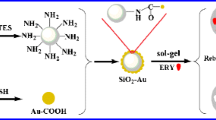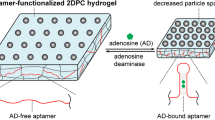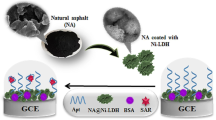Abstract
A porous phospholipid nanoshell (PPN) sensor functionalized with a specific aptamer sensor agent was prepared for rapid detection of Hg2+ in human urine with minimal sample preparation. Aptamer sensors provide an important class of optical transducers that can be readily and reproducibly synthesized. A key limitation of aptamer sensors, and many other optical sensors, is the potential of biofouling or biodegradation when used in complex biological matrices such as serum or urine, particularly when high levels of nucleases are present. We prepared Hg2+-responsive, PPN-encapsulated aptamer sensors that overcome these limitations. PPNs provide a protective barrier to encapsulate the aptamer sensor in an aqueous environment free of diffusional restrictions encountered with many polymer nanomaterials. The unique porous properties of the PPN membrane enable ready and rapid transfer of small molecular weight ions and molecules into the sensor interior while minimizing the macromolecular interactions between the transducer and degradants or interferents in the exterior milieu. Using Hg2+-responsive, PPN-encapsulated aptamer sensors, we were able to detect sub-100 ppb (chronic threshold limit from urine test) Hg2+ in human urine with no sample preparation, whereas free aptamer sensors yielded inaccurate results due to interferences from the matrix. The PPN architecture provides a new platform for construction of aptamer-functionalized sensors that target low molecular weight species in complex matrices, beyond the Hg2+ demonstrated here.

Schematic of Hg2+ sensor platform. An Hg2+-responsive aptamer was encapulated in a porous phospholipid nanoshell to minimize biofouling and improve sensor response and lifetime





Similar content being viewed by others
References
Li P, Feng XB, Qiu GL (2010) Methylmercury exposure and health effects from rice and fish consumption: a review. Int J Environ Res Public Health 7:2666–2691
Li P, Feng XB, Shang LH, Qiu GL, Meng B, Liang P, Zhang H (2008) Mercury pollution from artisanal mercury mining in Tongren, Guizhou, China. Appl Geochem 23:2055–2064
Li P, Feng XB, Qiu GL, Shang LH, Li ZG (2009) Mercury pollution in Asia: a review of the contaminated sites. J Hazard Mater 168:591–601
Lee SJ, Seo YC, Jang HN, Park KS, Baek JI, An HS, Song KC (2006) Speciation and mass distribution of mercury in a bituminous coal-fired power plant. Atmos Environ 40:2215–2224
Zhang L, Zhuo YQ, Chen L, Xu XC, Chen CH (2008) Mercury emissions from six coal-fired power plants in China. Fuel Process Technol 89:1033–1040
Weiner JA, Nylander M (1995) An estimation of the uptake of mercury from amalgam fillings based on urinary-excretion of mercury in Swedish subjects. Sci Total Environ 168:255–265
World Health Organization (2008) Guidance for identifying populations at risk from mercury exposure
Liu CW, Huang CC, Chang HT (2009) Highly selective DNA-based sensor for lead(II) and mercury(II) ions. Anal Chem 81:2383–2387
Ono A, Togashi H (2004) Highly selective oligonucleotide-based sensor for mercury(II) in aqueous solutions. Angew Chem Int Ed 43:4300–4302
Chan WH, Yang RH, Wang KM (2001) Development of a mercury ion-selective optical sensor based on fluorescence quenching of 5,10,15,20-tetraphenylporphyrin. Anal Chim Acta 444:261–269
Hassan SSM, Saleh MB, Gaber AAA, Mekheimer RAH, Kream NAA (2000) Novel mercury (II) ion-selective polymeric membrane sensor based on ethyl-2-benzoyl-2-phenylcarbamoyl acetate. Talanta 53:285–293
Kuswandi B, Narayanaswamy R (1999) Capillary optode: determination of mercury(II) in aqueous solution. Anal Lett 32:649–664
Kuswandi B, Narayanaswamy R (2001) Selective pool optode for mercury ion sensing in aqueous solution. Sensors Actuators B Chem 74:131–137
Maghasi AT, Conklin SD, Shtoyko T, Piruska A, Richardson JN, Seliskar CJ, Heineman WR (2004) Spectroelectrochemical sensing based on attenuated total internal reflectance stripping voltammetry. 2. Determination of mercury and lead. Anal Chem 76:1458–1465
Malcik N, Oktar O, Ozser ME, Caglar P, Bushby L, Vaughan A, Kuswandi B, Narayanaswamy R (1998) Immobilised reagents for optical heavy metal ions sensing. Sensors Actuators B Chem 53:211–221
Manganiello L, Rios A, Valcarcel M (2002) A method for screening total mercury in water using a flow injection system with piezoelectric detection. Anal Chem 74:921–925
Murkovic I, Wolfbeis OS (1997) Fluorescence-based sensor membrane for mercury(II) detection. Sensors Actuators B-Chemical 39:246–251
Palomares E, Vilar R, Durrant JR (2004) Heterogeneous colorimetric sensor for mercuric salts. Chem Commun 362–363
Prestel H, Gahr A, Niessner R (2000) Detection of heavy metals in water by fluorescence spectroscopy: on the way to a suitable sensor system. Fresenius J Anal Chem 368:182–191
Rogers B, Manning L, Jones M, Sulchek T, Murray K, Beneschott B, Adams JD, Hu Z, Thundat T, Cavazos H, Minne SC (2003) Mercury vapor detection with a self-sensing, resonating piezoelectric cantilever. Rev Sci Instrum 74:4899–4901
Volotovskky V, Kim N (2003) Ion-sensitive field effect transistor-based multienzyme sensor for alternative detection of mercury ions, cyanide, and pesticide. J Microbiol Biotechnol 13:373–377
Xu XH, Thundat TG, Brown GM, Ji HF (2002) Detection of Hg2+ using microcantilever sensors. Anal Chem 74:3611–3615
Yang RH, Wang KM, Xiao D, Luo K, Yang XH (2000) Determination of low-level mercury based on a renewable-drops sensing technique. Fresenius J Anal Chem 368:797–802
Yantasee W, Lin YH, Zemanian TS, Fryxell GE (2003) Voltammetric detection of lead(II) and mercury(II) using a carbon paste electrode modified with thiol self-assembled monolayer on mesoporous silica (SAMMS). Analyst 128:467–472
Zhang XB, Guo CC, Li ZZ, Shen GL, Yu RQ (2002) An optical fiber chemical sensor for mercury ions based on a porphyrin dimer. Anal Chem 74:821–825
Lee JS, Han MS, Mirkin CA (2007) Colorimetric detection of mercuric ion (Hg2+) in aqueous media using DNA-functionalized gold nanoparticles. Angew Chem Int Ed 46:4093–4096
Yu CJ, Tseng WL (2008) Colorimetric detection of mercury(II) in a high-salinity solution using gold nanoparticles capped with 3-mercaptopropionate acid and adenosine monophosphate. Langmuir 24:12717–12722
Wei H, Wang ZD, Yang LM, Tian SL, Hou CJ, Lu Y (2010) Lysozyme-stabilized gold fluorescent cluster: synthesis and application as Hg2+ sensor. Analyst 135:1406–1410
Shedge HY, Creager SE (2010) Evaluation of non-specific binding suppression schemes for neutravidin and alkaline phosphatase at the surface of reticulated vitreous carbon electrodes. Anal Chim Acta 657:154–162
Clark HA, Hoyer M, Philbert MA, Kopelman R (1999) Optical nanosensors for chemical analysis inside single living cells. 1. Fabrication, characterization, and methods for intracellular delivery of PEBBLE sensors. Anal Chem 71:4831–4836
Brasuel M, Kopelman R, Miller TJ, Tjalkens R, Philbert MA (2001) Fluorescent nanosensors for intracellular chemical analysis: decyl methacrylate liquid polymer matrix and ion exchange-based potassium PEBBLE sensors with real-time application to viable rat C6 glioma cells. Anal Chem 73:2221–2228
Xu H, Aylott JW, Kopelman R (2002) Fluorescent nano-PEBBLE sensors designed for intracellular glucose imaging. Analyst 127:1471–1477
Nielsen LJ, Olsen LF, Ozalp VC (2010) Aptamers embedded in polyacrylamide nanoparticles: a tool for in vivo metabolite sensing. ACS Nano 4:4361–4370
Cheng ZL, D’Ambruoso GD, Aspinwall CA (2006) Stabilized porous phospholipid nanoshells. Langmuir 22:9507–9511
O’Brien DF, Armitage BA, Benedicto A, Bennett DE, Lamparski HG, Lee YS, Srisiri W, Sisson TM (1998) Polymerization of preformed self-organized assemblies. Acc Chem Res 31:861–868
Mueller A, O’Brien DF (2002) Supramolecular materials via polymerization of mesophases of hydrated amphiphiles. Chem Rev 102:727–757
Lamparski H, Lee YS, Sells TD, O’Brien DF (1993) Thermotropic properties of model membranes composed of polymerizable lipids. 1. Phosphatidylcholines containing terminal acryloyl, methacryloyl, and sorbyl groups. J Am Chem Soc 115:8096–8102
Muhandiramlage TP, Cheng Z, Roberts DL, Keogh JP, Hall HK Jr, Aspinwall CA (2012) Determination of pore sizes and relative porosity in porous nanoshell architectures using dextran retention with single monomer resolution and proton permeation. Anal Chem 84:9754–9761
Lamparski H, Liman U, Barry JA, Frankel DA, Ramaswami V, Brown MF, Obrien DF (1992) Photoinduced destabilization of liposomes. Biochemistry 31:685–694
Cheng ZL, Luisi PL (2003) Coexistence and mutual competition of vesicles with different size distributions. J Phys Chem B 107:10940–10945
New RRC (1990) Liposomes: a practical approach. Oxford University Press, Oxford
Kolchens S, Ramaswami V, Birgenheier J, Nett L, Obrien DF (1993) Quasi-elastic light-scattering determination of the size distribution of extruded vesicles. Chem Phys Lipids 65:1–10
You M, Chen Y, Peng L, Han D, Yin B, Ye B, Tan W (2011) Engineering DNA aptamers for novel analytical and biomedical applications. Chem Sci 2:1003–1010
Kuklenyik Z, Marzilli LG (1996) Mercury(II) site-selective binding to a DNA hairpin. Relationship of sequence-dependent intra- and interstrand cross-linking to the hairpin-duplex conformational transition. Inorg Chem 35:5654–5662
Nakada S, Inoue K, Nojima S, Imura N (1978) Change in permeability of liposomes caused by methylmercury and inorganic mercury. Chem Biol Interact 22:15–23
Fowler BA (1993) Mechanisms of kidney cell injury from metals. Environ Health Prospect 100:57–63
Pesce AJ, Hanenson I, Sethi K (1977) beta2 microglobulinuria in a patient with nephrotoxicity secondary to mercuric chloride ingestion. Clin Toxicol 11:309–315
Ferguson MA, Vaidya VS, Bonventre JV (2008) Biomarkers of nephrotoxic acute kidney injury. Toxicology 245:182–193
Acknowledgments
This work was supported in part by grants from NIH (GM074522 and GM095763) and NSF (CHE-0548167).
Author information
Authors and Affiliations
Corresponding author
Additional information
Published in the topical collection celebrating ABCs 13th Anniversary.
Electronic supplementary material
Below is the link to the electronic supplementary material.
ESM 1
(PDF 47 kb)
Rights and permissions
About this article
Cite this article
Li, Z., Muhandiramlage, T.P., Keogh, J.P. et al. Aptamer-functionalized porous phospholipid nanoshells for direct measurement of Hg2+ in urine. Anal Bioanal Chem 407, 953–960 (2015). https://doi.org/10.1007/s00216-014-8246-1
Received:
Revised:
Accepted:
Published:
Issue Date:
DOI: https://doi.org/10.1007/s00216-014-8246-1




